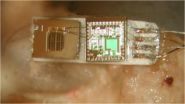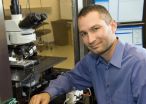(Press-News.org) Alu elements infiltrated the ancestral primate genome about 65 million years ago. Once gained an Alu element is rarely lost so comparison of Alu between species can be used to map primate evolution and diversity. New research published in BioMed Central's open access journal Mobile DNA has found a single Alu, which appears to be an ancestral great ape Alu, that has uniquely multiplied within the orangutan genome.
Analysis of DNA sequences has found over a million Alu elements within each primate genome, many of which are species specific: 5,000 are unique to humans, while 2,300 others are exclusive to chimpanzees. In contrast the orangutan lineage (Sumatran and Bornean orangutans) only has 250 specific Alu.
These tiny pieces of mobile DNA are able to copy themselves using a method similar to retroviruses. But, because this is an inexact process, a segment of 'host' DNA is duplicated at the Alu insertion sites and these footprints, known as 'target site duplications', can be used to 'identify' Alu insertions. Alu elements can be thought of as molecular fossils, and a shared Alu element sequence and location within the genome indicates a common ancestor.
Researchers from Louisiana State University, in collaboration with the Zoological Society of San Diego and the Institute of Systems Biology in Seattle, found a single Alu which is present in great apes, but absent from gibbons and siamang, and so was likely acquired after ancestors of these species diverged. This founder Alu element was found in an intron (non-coding DNA) on chromosome 7.
Subsequent copying of this Alu, visible as insertions into chromosomes 4, 17, and 12, are unique to orangutans, suggesting that the founder Alu inserted before orangutans separated from other members of the Hominidae (humans, gorillas, and chimpanzees). The Sumatran orangutan also has a copy of this Alu in chromosome 13, and has gained a daughter Alu, which rapidly expanded into chromosomes 21, 2b, and 17. These extra insertions are able to pinpoint the divergence of Sumatran and Bornean orangutans.
The ancestral Alu has been much less active in other great apes, but can still provide information about speciation. While still on chromosome 7 the Alu gained three mutations which can be traced to before the split of gorillas with humans and chimpanzees. It subsequently copied itself into chromosome 3 of humans, indicating that this must have occurred after humans split from bonobos and chimpanzees.
Prof Batzer, who led this research along with Jerilyn Walker and Miriam Konkel, explained "Despite otherwise low activity of Alu retrotransposition in orangutans, this ancestral Alu, still present on chromosome 7, has duplicated more rapidly in orangutans than other Hominidae and likely served as an ancient backseat driver that contributed to the recent orangutan-specific expansion of the Alu family."
###
Media Contact
Dr Hilary Glover
Scientific Press Officer, BioMed Central
Tel: +44 (0) 20 3192 2370
Mob: +44 (0) 778 698 1967
Email: hilary.glover@biomedcentral.com
Notes to Editors
1. Orangutan Alu Quiescence Reveals Possible Source Element: Support for Ancient Backseat Drivers
Jerilyn A Walker, Miriam K Konkel, Brygg Ullmer, Christopher P Monceaux, Oliver A Ryder, Robert Hubley, Arian F A Smit and Mark A Batzer
Mobile DNA (in press)
Please name the journal in any story you write. If you are writing for the web, please link to the article. All articles are available free of charge, according to BioMed Central's open access policy.
Article citation and URL available on request on the day of publication.
2. Mobile DNA is an online, peer-reviewed, open access journal that publishes articles providing novel insights into DNA rearrangements, ranging from transposition and other types of recombination mechanisms to patterns and processes of mobile element and host genome evolution.
3. BioMed Central (http://www.biomedcentral.com/) is an STM (Science, Technology and Medicine) publisher which has pioneered the open access publishing model. All peer-reviewed research articles published by BioMed Central are made immediately and freely accessible online, and are licensed to allow redistribution and reuse. BioMed Central is part of Springer Science+Business Media, a leading global publisher in the STM sector.
Orangutans harbor ancient primate Alu
2012-04-30
ELSE PRESS RELEASES FROM THIS DATE:
Breastfeeding is associated with a healthy infant gut
2012-04-30
Early colonization of the gut by microbes in infants is critical for development of their intestinal tract and in immune development. A new study, published in BioMed Central's open access journal Genome Biology, shows that differences in bacterial colonization of formula-fed and breast-fed babies leads to changes in the infant's expression of genes involved in the immune system, and in defense against pathogens.
The health of individuals can be influenced by the diversity of microbes colonizing the gut, and microbial colonization can be especially important in regulating ...
A middle-ear microphone
2012-04-30
SALT LAKE CITY, April 30, 2012 – Cochlear implants have restored basic hearing to some 220,000 deaf people, yet a microphone and related electronics must be worn outside the head, raising reliability issues, preventing patients from swimming and creating social stigma.
Now, a University of Utah engineer and colleagues in Ohio have developed a tiny prototype microphone that can be implanted in the middle ear to avoid such problems.
The proof-of-concept device has been successfully tested in the ear canals of four cadavers, the researchers report in a study just published ...
Yellowstone 'super-eruption' less super, more frequent than thought
2012-04-30
PULLMAN, Wash.— The Yellowstone "super-volcano" is a little less super—but more active—than previously thought.
Researchers at Washington State University and the Scottish Universities Environmental Research Centre say the biggest Yellowstone eruption, which created the 2 million year old Huckleberry Ridge deposit, was actually two different eruptions at least 6,000 years apart.
Their results paint a new picture of a more active volcano than previously thought and can help recalibrate the likelihood of another big eruption in the future. Before the researchers split ...
Gladstone scientists identify brain circuitry associated with addictive, depressive behaviors
2012-04-30
SAN FRANCISCO, CA—April 29, 2012—Scientists at the Gladstone Institutes have determined how specific circuitry in the brain controls not only body movement but also motivation and learning, providing new insight into neurodegenerative disorders such as Parkinson's disease—and psychiatric disorders such as addiction and depression.
Previously, researchers in the laboratory of Gladstone Investigator Anatol Kreitzer, PhD, discovered how an imbalance in the activity of a specific category of brain cells is linked to Parkinson's. Now, in a paper published online today in Nature ...
Tablet-based case conferences improve resident learning
2012-04-30
Tablet based conference mirroring is giving residents an up close and personal look at images and making radiology case conferences a more interactive learning experience, a new study shows.
Residents at Northwestern University in Chicago are using tablets and a free screen sharing software during case conferences to see and manipulate the images that are being presented.
"The idea stems from the fact that I was used to having presentation slides directly in front of me during medical school lectures. I thought this would benefit radiology residents, especially in ...
MR enterography is as good or better than standard imaging exams for pediatric Crohn's patients
2012-04-30
MR enterography is superior to CT enterography in diagnosing fibrosis in pediatric patients with Crohn disease and equally as good as CT enterography in detecting active inflammation, and a new study shows.
The study, conducted at Massachusetts General Hospital in Boston, found that MR enterography was 77.6% accurate in depicting fibrosis compared to 56.9% for CT enterography. MR enterography had an 82.1% accuracy rate versus 77.6% accuracy rate for CT enterography for detecting active inflammation, said Keith Quencer, MD, one of the authors of the study. The study ...
Radiologists rank themselves as less than competent on health policy issues
2012-04-30
Radiologists classify themselves as less competent than other physicians regarding knowledge of patient imaging costs and patient safety, a new study shows.
The study conducted at Thomas Jefferson University in Philadelphia and Northwestern University in Chicago compared 711 radiologists to 2,685 non-radiology physicians. "On a scale of one to five, with five being highly competent, understanding of patient safety was rated as 3.1 by radiologists and 3.33 by non-radiologists," said Rajni Natesan, MD, an author of the study from Northwestern University. Patient imaging ...
Study examines benefit of follow-up CT when abdominal ultrasound inconclusive
2012-04-30
About one-third of CT examinations performed following an inconclusive abdominal ultrasound examination have positive findings, according to a study of 449 patients at Massachusetts General Hospital in Boston.
Opinions vary as to the need and relevance for further diagnostic imaging workup after an inconclusive abdominal ultrasound examination, said Supriya Gupta, MD, one of the authors of the study. "Our study found that 32.9% of follow-up CT examinations had positive findings, while 42.7% had findings that were not significant and 11.7% were equivocal. The remaining ...
Researchers question pulling plug on pacifiers
2012-04-30
BOSTON – Binkies, corks, soothers. Whatever you call pacifiers, conventional wisdom holds that giving them to newborns can interfere with breastfeeding.
New research, however, challenges that assertion. In fact, limiting the use of pacifiers in newborn nurseries may actually increase infants' consumption of formula during the birth hospitalization, according to a study to be presented Monday, April 30, at the Pediatric Academic Societies (PAS) annual meeting in Boston.
Studies have shown that breastfed infants have fewer illnesses such as ear infections and diarrhea ...
One-third of adult Americans with arthritis battle anxiety or depression
2012-04-30
Researchers from the Centers for Disease Control and Prevention (CDC) found that one-third of U.S. adults with arthritis, 45 years and older, report having anxiety or depression. According to findings that appear today in Arthritis Care & Research, a journal published by Wiley-Blackwell on behalf of the American College of Rheumatology (ACR), anxiety is nearly twice as common as depression among people with arthritis, despite more clinical focus on the latter mental health condition.
In the U.S. 27 million individuals, 25 years of age and older, have doctor diagnosed ...

